|
Infiltration: 1999 Journal
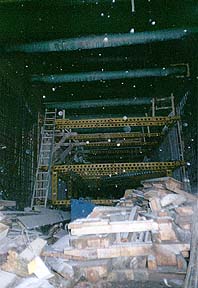 Sheppard Subway Construction Site (19 February 1999): It was about 8p.m. and I'd finished visiting a friend at Yonge and Sheppard (Toronto). I noticed that the normally teeming construction site was completely unpopulated. I wasn't dressed for it or equipped with a proper flashlight, but I couldn't really resist, so I pulled back a flimsy rubber fence and slid through. I waded through the soggy mud until I found a slope leading down into the pit. I slipped and slid most of the way down, but climbed down a few ladders as well where these were provided.
Sheppard Subway Construction Site (19 February 1999): It was about 8p.m. and I'd finished visiting a friend at Yonge and Sheppard (Toronto). I noticed that the normally teeming construction site was completely unpopulated. I wasn't dressed for it or equipped with a proper flashlight, but I couldn't really resist, so I pulled back a flimsy rubber fence and slid through. I waded through the soggy mud until I found a slope leading down into the pit. I slipped and slid most of the way down, but climbed down a few ladders as well where these were provided.
I guess the tunnel -- well, I suppose it's more of a pit than a tunnel, but it's a very deep, very narrow and partially covered pit -- is about 40ft. or 12m deep. The top of the pit was covered in thick metal tubes. Cement had just begun to be poured into the tunnel in sections, but mostly I was walking through mud or on sheets of plastic. There were a fair number of structures to climb around on but nothing really fascinating. After touring for a while, I climbed out via a series of very shaky makeshift wooden ladders.
The Sheppard tunnels aren't quite ready for primetime yet, but they're getting there. I'll be following the construction closely over the next two years so stay tuned.
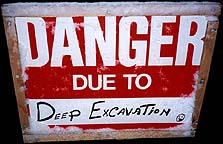 |
"Deep Excavation" (happy face)...
I guess they were just joking. |
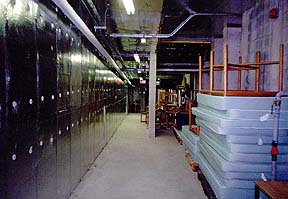 Brock University Steam Tunnels (20 February 1999): I visited Brock University (St. Catharines, Ontario) with those documentary people. We arrived on campus around noon, and were ushered into the tunnel system by a friendly physical plant guy, who pretty much just let us inside and then took off for the day.
Brock University Steam Tunnels (20 February 1999): I visited Brock University (St. Catharines, Ontario) with those documentary people. We arrived on campus around noon, and were ushered into the tunnel system by a friendly physical plant guy, who pretty much just let us inside and then took off for the day.
The Brock tunnels are the safest, coolest (temperature-wise) tunnels I've ever visited. Physical plant workers are in the tunnels all the time, and ride quickly through the tunnels on bicycles. In spite of this very tame quality, the Brock tunnels were quite interesting. They are very closely integrated with the school itself; whereas most steam tunnels just hook up with mechanical rooms underneath various colleges, these tunnels opened right out into the main hallways of the campus (locked on the student side, of course).
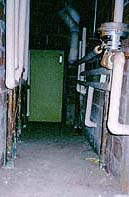
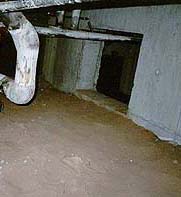

I also got a kick out of two neat areas we discovered. At the end of a small narrow shaft, we found a three-foot tall green door. Naturally, we had to find out what went on behind the green door, so we pulled it back and hopped in. It was a tiny, unlit crawlspace with concrete walls and sand floors (?). Several other rooms with sand floors were connected. After being in here for just a few minutes, the dust got hard to bear. Continuing our travels, before long we found another gigantic crawlspace filled with odd machinery, only here the floor was coated with large rocks. Nice.
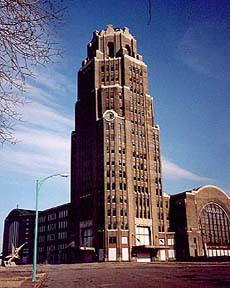 Buffalo Central Terminal (27 February 1999): I went to check out the abandoned Buffalo (New York) Central Terminal with the documentary people and Lefty and L.B. of Jinx magazine.
Buffalo Central Terminal (27 February 1999): I went to check out the abandoned Buffalo (New York) Central Terminal with the documentary people and Lefty and L.B. of Jinx magazine.
I arrived at about 11a.m., and talked with Lefty and L.B. out front just
briefly before we all headed inside the gigantic, decaying monolith of a
building. The front door was wide open, because the film crew had obtained
permission of a sort to film inside the building, but it would have been a
very simple matter to enter the building through an alternate entrance. The
building is absolutely gigantic and there are hundreds of potential
entrances, so I doubt it will ever be sealed off totally.
The crew had secured two cameras and two audio recorders for the day,
so one camera followed the Jinx guys on their mission to conquer the
rooftops (heights are their main thing), while another camera followed me in
my search for tunnels and other interesting sights.
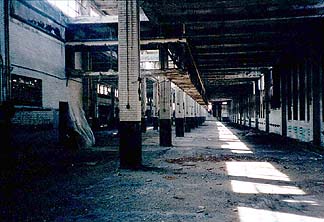 I led my half of the crew back outside and into a long, low building that,
it seemed to me, had served freight trains rather than passenger trains. I
explored several rooms, including unlit storage rooms and extremely
vandalized washrooms, before finding a tall metal ladder leading up. I
clambered up into a very tempting dark hallway where much of the roof had
collapsed onto the floor, and then had to wait impatiently for the film crew
to catch up. We then walked around the top of the building on a catwalk,
which was fun, though I sensed that the people lugging the heavy equipment
up and down the ladders were enjoying all the multi-level action less than I
was.
I led my half of the crew back outside and into a long, low building that,
it seemed to me, had served freight trains rather than passenger trains. I
explored several rooms, including unlit storage rooms and extremely
vandalized washrooms, before finding a tall metal ladder leading up. I
clambered up into a very tempting dark hallway where much of the roof had
collapsed onto the floor, and then had to wait impatiently for the film crew
to catch up. We then walked around the top of the building on a catwalk,
which was fun, though I sensed that the people lugging the heavy equipment
up and down the ladders were enjoying all the multi-level action less than I
was.
After descending to ground level, I found a stairwell leading underground.
At the bottom of the stairs, the top half a wooden door was jutting out of
the floor at an odd angle. As I was about to trust my weight to this
'floor', someone called out "it’s ice!" They were right -- the room at the
bottom of the stairs was flooded with about eight feet of frozen water. I
tentatively tested the ice with my foot and, finding it quite solid, crawled
out onto the ice and through the top of a doorway leading into the room
beyond. I crawled through a series of these rooms, right at the roof level,
but they didn't seem connected to tunnels and the crew wasn't really
interested in trusting the ice, so we gave up on that and headed up to
the roof.
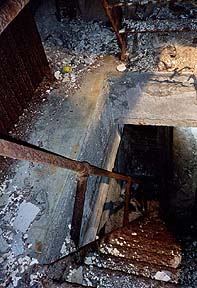
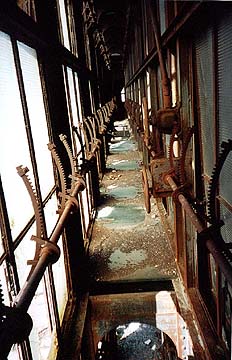
On the roof of the freight building, we looked up and saw Lefty, L.B. and
the other half of the crew standing atop the station’s tallest tower, where
they were draping a flag containing the Jinx logo over the side of the
building. We waved at them and filmed them from below. I spotted a hole in
the cement wall separating the roof of our building from the fourth storey
of their building, so we all climbed through into the main part of the
station. We were in a dark room filled with burned record books and very
narrow staircases leading up and down, and a door leading off somewhere
else. We decided to head down first. At the bottom of those stairs, we found
more doors, more rooms, more stairs! I wanted to go in every direction at
once, but alas, I had to pick. I was generally kind to the crew in picking
the path of least resistance. We climbed down in between the inner and outer
panes of the big arched windows that overlook the station’s great hall.
These were quite shattered, and I grabbed a large, thick hunk of glass as a
souvenir.
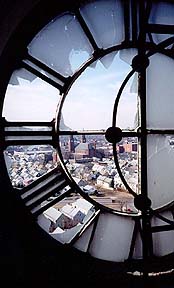 We crossed down to the second storey and did more general tourism. Among the
more memorable sights we took in were a flooded, frozen library filled with
record books and ancient frozen typewriters, an open but empty safe, some
open elevator shafts and several different flights of stairs leading up. We
gradually made our way up the main tower, stopping every couple of floors to
investigate the abandoned offices on a particular level. Some were covered
in charred record books, while others were surprisingly clean. Record books
were in abundance throughout the building; one stairwell we took was coated
with several feet of old record books that we had to climb on top of. We
found the elevators hanging suspended in the shaft on the 9th floor; then
five or six floors higher we stumbled upon the huge clocks that once
broadcasted the time to all of suburban Buffalo. Most of the gears were gone
but the glass-and-iron clock faces were still more or less intact.
We crossed down to the second storey and did more general tourism. Among the
more memorable sights we took in were a flooded, frozen library filled with
record books and ancient frozen typewriters, an open but empty safe, some
open elevator shafts and several different flights of stairs leading up. We
gradually made our way up the main tower, stopping every couple of floors to
investigate the abandoned offices on a particular level. Some were covered
in charred record books, while others were surprisingly clean. Record books
were in abundance throughout the building; one stairwell we took was coated
with several feet of old record books that we had to climb on top of. We
found the elevators hanging suspended in the shaft on the 9th floor; then
five or six floors higher we stumbled upon the huge clocks that once
broadcasted the time to all of suburban Buffalo. Most of the gears were gone
but the glass-and-iron clock faces were still more or less intact.
I failed to note on what storey, but eventually we left behind the office
floors and started hitting the old mechanical rooms near the top of the
building, which were incredibly cool. These were lit with afternoon sunlight
pouring in through windows and holes in the walls, and covered with a thick
layer of dust, so it felt like we were climbing around inside an Egyptian
pyramid. There were ladders and nooks everywhere. We took a relatively
straight path up to the roof, where we had an incredible view of the
decaying metropolis of Buffalo in all its glory from 20 storeys up.
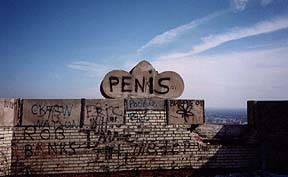 After a little more exploring of the upper levels, we had to head back down
to meet with the other crew. We were setting up for an interview in the
great hall when a couple in their 50s walked in and said hello. The producer
mentioned that we were filming a documentary, and the couple offered to
leave, but we encouraged them to stay and have a look around. They explained
that they were just back visiting for the memories. The terminal had been
where the man had shipped off to the Korean War, and it was even more
significant to the woman, whose first husband had been killed in an accident
while working there as a mechanic decades ago. The man talked about how
they'd just been to Toronto and it seemed so big and prosperous that it made
them sad for Buffalo, which had once seemed to be a city poised for
greatness. They reminisced at length about how the great hall had once been
continuously filled with thousands of people, and dozens of busy shops and
restaurants. The man explained that it had always been kept immaculate:
never a ticket or even a cigarette ash on the floor. The woman interjected
that they had always dressed up in their Sunday best before coming to the
train station. The man told us that all the floors had been made out of
polished marble. We scraped off a few centimeters of dirt with our shoes and
showed him that it still was, and I told him that it was still a beautiful
building. They shook our hands, wandered around a bit more and then left.
After a little more exploring of the upper levels, we had to head back down
to meet with the other crew. We were setting up for an interview in the
great hall when a couple in their 50s walked in and said hello. The producer
mentioned that we were filming a documentary, and the couple offered to
leave, but we encouraged them to stay and have a look around. They explained
that they were just back visiting for the memories. The terminal had been
where the man had shipped off to the Korean War, and it was even more
significant to the woman, whose first husband had been killed in an accident
while working there as a mechanic decades ago. The man talked about how
they'd just been to Toronto and it seemed so big and prosperous that it made
them sad for Buffalo, which had once seemed to be a city poised for
greatness. They reminisced at length about how the great hall had once been
continuously filled with thousands of people, and dozens of busy shops and
restaurants. The man explained that it had always been kept immaculate:
never a ticket or even a cigarette ash on the floor. The woman interjected
that they had always dressed up in their Sunday best before coming to the
train station. The man told us that all the floors had been made out of
polished marble. We scraped off a few centimeters of dirt with our shoes and
showed him that it still was, and I told him that it was still a beautiful
building. They shook our hands, wandered around a bit more and then left.
Once the film crew had pretty much run out of film for the day, they got
ready to pack everything up. An eager member of the crew named Ian
and I asked if we could be excused to check out some stairs we'd
found earlier leading down from the kitchen. These stairs took us down three
levels (each of which we probably could've explored for an hour if we'd had
time) to a series of cold, pitch-black steam tunnels deep under the station.
We explored these tunnels as much as we could, but large sections were
flooded and the ice didn't seem very thick. Too bad, because we could see
more stairs ahead of us in one of the inaccessible areas.
Going up a level, we continued our explorations of the station’s
subbasements. There were dozens and dozens of tempting doors, hallways and
staircases that we had to ignore because we didn't have enough time to
investigate everything. We found an old storage room where there was straw
all over the floor and a fridge in the corner; it looked like bums had once
lived there. I found a large-sized pink t-shirt reading “Hard to Please
Lady” hanging from some mechanical equipment and I couldn't help but take
it, because I knew it would make a perfect addition to my wardrobe.
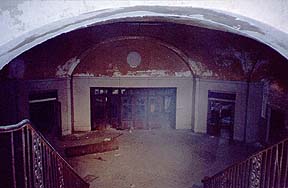 Shortly after this, we wandered outside, into a back alley behind the
station, where we met up with two guys in their 20s who were taking
pictures. They asked us about what the inside of the station was like, and
told us they were taking pictures for a contest a Buffalo art gallery was
having called “images of the Buffalo Central Terminal” or something. They’d
neglected to bring flashlights, though, so they wouldn't have gotten far
inside the building. After a bit of poking around inside the building on the
other side of the alley, a police car cruised by us really slowly on the
other side of a cement wall. The cops obviously wanted us to come over and
explain ourselves, but we didn't feel like it, and they didn't feel like
getting out of their car, so it was a stalemate. We invited the
photographers to come with us back inside the building, and we showed them
some of the more impressive sights we'd seen in the subbasements, like the
corridor containing a car stripped bare, a big subterranean reception hall
of some sort, and cement walls erected halfway up ornate staircases.
Shortly after this, we wandered outside, into a back alley behind the
station, where we met up with two guys in their 20s who were taking
pictures. They asked us about what the inside of the station was like, and
told us they were taking pictures for a contest a Buffalo art gallery was
having called “images of the Buffalo Central Terminal” or something. They’d
neglected to bring flashlights, though, so they wouldn't have gotten far
inside the building. After a bit of poking around inside the building on the
other side of the alley, a police car cruised by us really slowly on the
other side of a cement wall. The cops obviously wanted us to come over and
explain ourselves, but we didn't feel like it, and they didn't feel like
getting out of their car, so it was a stalemate. We invited the
photographers to come with us back inside the building, and we showed them
some of the more impressive sights we'd seen in the subbasements, like the
corridor containing a car stripped bare, a big subterranean reception hall
of some sort, and cement walls erected halfway up ornate staircases.
Unfortunately, we ran out of time before long, and after being lost for a
brief time, we made our way back up to the great hall to meet up with the
rest of our group. Although it had been a long day and I was extremely cold
and hungry (I’d brought drinks but not food), I was still frustrated to have
to leave the magnificent station. We’d been there for about six hours, and I
don't think we'd seen more than a third of what this tremendous place had to
offer. I’ll definitely be heading back.
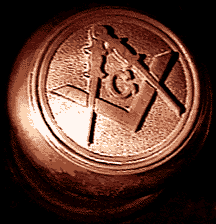 Masonic Temple/Concert Hall (19 March 1999): Around two and a half years ago, I took my first in-depth look behind the scenes at the Masonic Temple/Concert Hall at Yonge and Davenport (Toronto). The occasion was the fifth anniversary party of
Exclaim magazine. I went for the zine show, but that turned out to be really small and pathetic so some friends and I quickly turned our attention to the very old, very lovely building we were in, which was built by the Masons many decades ago, but later became one of Toronto's main concert venues. Security was terrible, so we managed to get several floors underground to the deepest subbasements, into huge darkened concert halls, into old abandoned-looking kitchens, storage rooms and changerooms, and even through an elevator room and out onto the roof. We had a great time, even hooking up with another small group of explorers (who tried posing as security guards until they found themselves unable to keep straight faes).
Masonic Temple/Concert Hall (19 March 1999): Around two and a half years ago, I took my first in-depth look behind the scenes at the Masonic Temple/Concert Hall at Yonge and Davenport (Toronto). The occasion was the fifth anniversary party of
Exclaim magazine. I went for the zine show, but that turned out to be really small and pathetic so some friends and I quickly turned our attention to the very old, very lovely building we were in, which was built by the Masons many decades ago, but later became one of Toronto's main concert venues. Security was terrible, so we managed to get several floors underground to the deepest subbasements, into huge darkened concert halls, into old abandoned-looking kitchens, storage rooms and changerooms, and even through an elevator room and out onto the roof. We had a great time, even hooking up with another small group of explorers (who tried posing as security guards until they found themselves unable to keep straight faes).
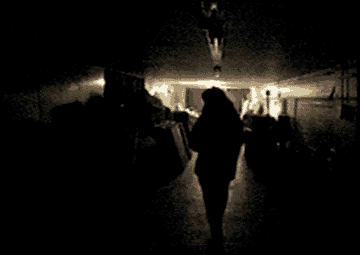 On a subsequent trip (at the following year's Exclaim party), Ultraviolet and I were at first thwarted by the much improved security, but eventually stumbled upon an unlocked door. Swiftly running through some unlit rooms and up a darkened staircase, we found ourselves on the 300 level (third floor up). As we continued our ascent and began touring the 400 level, we heard loud voices behind us and began to get nervous. Some guys opened a door and when they saw us said "oh sorry", and shut the door. I immediately re-opened the door and asked them what they were doing up here, and when they sheepishly (and somewhat drunkenly) told us they were just looking around, we began to trade tips. On a subsequent trip (at the following year's Exclaim party), Ultraviolet and I were at first thwarted by the much improved security, but eventually stumbled upon an unlocked door. Swiftly running through some unlit rooms and up a darkened staircase, we found ourselves on the 300 level (third floor up). As we continued our ascent and began touring the 400 level, we heard loud voices behind us and began to get nervous. Some guys opened a door and when they saw us said "oh sorry", and shut the door. I immediately re-opened the door and asked them what they were doing up here, and when they sheepishly (and somewhat drunkenly) told us they were just looking around, we began to trade tips.
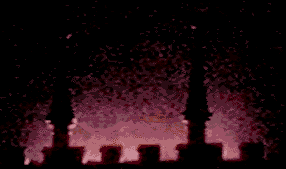 Our new tour guides led us up to the 600-level to show us what they called the gallery: a mezzanine looking down on a huge, sunken ceremonial hall for the masons. This place was very dimly lit and very creepy, and our guides quickly took off, telling us they were off in search of the coffins. Ultraviolet and I were fascinated by the evil feel of the place, though, and took some stairs down to get a closer look. The walls and chairs were dark, ornately carved wood, and the carpets, lighting and upholstery were all deep, blood red, creating what must've been a deliberately Satanic atmosphere. A series of tall wooden thrones rested on an elevated platform at the centre of the room, underneath the obligatory wooden carving of the eye in the pyramid. Though chilled by the atmosphere and the constant loud creaking and echoes in this part of the building, we toured behind and above the scenes by the light of a pocket flashlight, exploring old lockers that seemed to have been ransacked some time ago. Our new tour guides led us up to the 600-level to show us what they called the gallery: a mezzanine looking down on a huge, sunken ceremonial hall for the masons. This place was very dimly lit and very creepy, and our guides quickly took off, telling us they were off in search of the coffins. Ultraviolet and I were fascinated by the evil feel of the place, though, and took some stairs down to get a closer look. The walls and chairs were dark, ornately carved wood, and the carpets, lighting and upholstery were all deep, blood red, creating what must've been a deliberately Satanic atmosphere. A series of tall wooden thrones rested on an elevated platform at the centre of the room, underneath the obligatory wooden carving of the eye in the pyramid. Though chilled by the atmosphere and the constant loud creaking and echoes in this part of the building, we toured behind and above the scenes by the light of a pocket flashlight, exploring old lockers that seemed to have been ransacked some time ago.
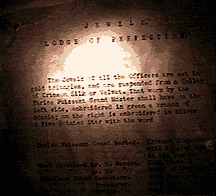 In another completely unlit area, we found what seemed to be a prop room, filled with many old props, some of which seemed to be for masonic ceremonies, such as candles, robes and lamps, and some of which can only have been for plays, such as military camouflage and costumes. We also found a sheet glued to the inside door of a wardrobe describing the positions of the different levels of masons and the decorations to which each was entitled. This floor was very creepy, so we were glad to leave it in search of the roof.
In another completely unlit area, we found what seemed to be a prop room, filled with many old props, some of which seemed to be for masonic ceremonies, such as candles, robes and lamps, and some of which can only have been for plays, such as military camouflage and costumes. We also found a sheet glued to the inside door of a wardrobe describing the positions of the different levels of masons and the decorations to which each was entitled. This floor was very creepy, so we were glad to leave it in search of the roof.
Getting onto the roof was almost too easy, we just walked up another unlit staircase, pulled back the lock on a big black iron door, and there we were, standing seven or eight storeys above Yonge and Bloor at 1:30a.m. on a Saturday night. We took pictures, and began exploring the roof, but decided to call that off when our feet started breaking through the spongy yet brittle roof surface. Not safe. Returning to the 400 level, we continued our explorations of the bizarre old storage rooms. After a bit of searching, we found the unlit staircase leading down to the subbasements and engine rooms, but decided against taking this route since it would involve traveling past backstage security on the lower levels. After a little more peeking around, took a different stairwell down to the basement and surprised the show employees by emerging from behind the curtain were they were keeping all the snacks and beer (and buckets full of un-torn beer tickets). We quickly reintegrated into the crowds and exited through a side door at about 2a.m.
In late February of this year, a reporter for the National Post e-mailed me to ask what I knew about the Masonic Temple. It turned out the reporter, Shannon Black, was a friend of the people who'd messed with my mind on my first expedition, and that she was writing an article about the Masonic Temple and how it had changed since the CTV television network bought the building. She seemed cool so I told her what I knew and then asked if she needed an assistant reporter when she went to investigate the next day. To my delight, she said she thought she could pull that off, so I met her, her cameraman, a Masonic historian named Wallace McLeod, and our official liason, the suspiciously-named Susan Mason, at the site the following afternoon.
The official part of our tour was quite tame. We visited the CTV offices, looked at the renovations that had been done to bring the building up to the fire code, and saw the set for the Mike Bullard show. While we were looking at some of the smaller rooms on the fourth floor, however, Ms. Mason realized she had to go put more money in her parking meter. I told Shannon I'd be back and quickly sprinted off towards the back stairwell.
It was good to be back. I headed up the stairs to the maintenance rooms at the top of the temple, where I found the exit and took a brief stroll out on the roof. Returning to the stairs, I skipped down seven flights to examine the boiler rooms under the basement. Many new metal supports had been added down here to make extra sure the ancient room didn't collapse in on itself. Ascending one flight, I investigated the various backstage areas in the basement and first floor, but took off when I heard Mike Bullard talking to a friend while approaching the dressing room I was investigating. I then rejoined the tour group upstairs, but the rest of the tour was more or less without surprises.
The article, "The Secrets of the Temple," ran in the 20 March edition of the National Post, together with nice colour pictures and the works. I can only guess how Susan Mason reacted to reading that she'd imported an infiltrator into her building, but about a week later I received a letter from Wallace McLeod telling me he'd enjoyed my website and would have talked to me more if he'd realized I was Ninjalicious!
Sheppard subway construction (several occasions 1999): I continued to probe the depths of the under-construction Sheppard line all month long, with varying degrees of success, but always having a really fantastic time. Over the course of six or seven different trips, I think I've finally managed to see all the most interesting sights, and I'm pretty sure the Sheppard subway will be the focus of Infiltration 13.
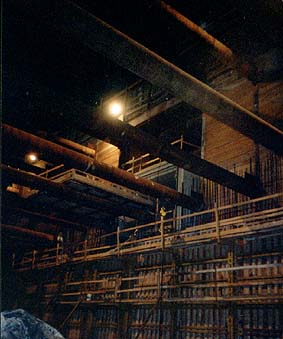 After meeting up with Leftist and his friend Sara at Fairview Mall, I lead them to the oversized viewing hole I'd used the week before and coaxed them through. We descended the seven storeys into the pit and I showed them around a bit. After peaking in on the blueprints, we continued to the west, crossing under the wooden boards supporting all the traffic on Don Mills seven storeys above.
After meeting up with Leftist and his friend Sara at Fairview Mall, I lead them to the oversized viewing hole I'd used the week before and coaxed them through. We descended the seven storeys into the pit and I showed them around a bit. After peaking in on the blueprints, we continued to the west, crossing under the wooden boards supporting all the traffic on Don Mills seven storeys above.
We came upon a large lake of wet cement, which we were able to circumvent without leaving tracks. The next hurdle was a vast, wet pit covered only by thin, crisscrossing metal bars. Sara and I tightrope-walked across these with relative ease, but the balance-impaired Leftist had quite a bit of trouble making it over. After the pit, we next entered a wide expanse of sand dunes and pits, and a fleet of small bulldozers and forklifts, which we somehow resisted using as bumper cars.
Leaving the sandy area, we came upon a tall wooden fence. We pried back one of the boards to reveal a large support wall with a gigantic tunnel boring machine sticking out of it! It seemed the TBM had just that day broken through from the Leslie tunnels into the Don Mills pit. After a few photos of the outside of the TBM, the three of us hopped through a gap in the tube wall to investigate the TBM and its lair.
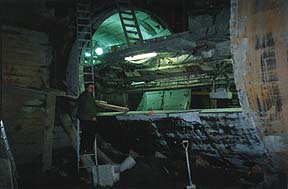 After another look at the TBM, I persuaded Leftist and Sara that we should walk down the tunnel towards Leslie. Our progress along the tracks was very slow, as the sloppy grey muck at our feet was quite deep, and there were no boards running along the side of the tunnel to make our journey easier. We'd travelled about a kilometer into the tunnel when Leftist declared that he needed a rest. While we waited, I thought I heard a voice off in the distance. Straining my eyes to see as far down the tunnel as possible, I thought I saw a vaguely humanoid figure wearing a hardhat, but I had to stare intently for several moments to determine that it was moving. I guess the worker felt my stare, because just then he started yelling at us, though we were so far away that I could barely hear his voice, let alone make out his words.
After another look at the TBM, I persuaded Leftist and Sara that we should walk down the tunnel towards Leslie. Our progress along the tracks was very slow, as the sloppy grey muck at our feet was quite deep, and there were no boards running along the side of the tunnel to make our journey easier. We'd travelled about a kilometer into the tunnel when Leftist declared that he needed a rest. While we waited, I thought I heard a voice off in the distance. Straining my eyes to see as far down the tunnel as possible, I thought I saw a vaguely humanoid figure wearing a hardhat, but I had to stare intently for several moments to determine that it was moving. I guess the worker felt my stare, because just then he started yelling at us, though we were so far away that I could barely hear his voice, let alone make out his words.
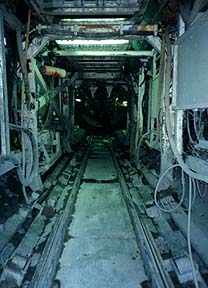 I turned around to face Leftist and Sara, who were absorbed in conversation and hadn't noticed the turn of events. In a voice that made it very clear I wasn't joking, I said "I think we should make as hasty a retreat as possible." I explained the details as we fled back up the tunnel. Sara was almost running along one rail, I was hopping from board to rail to board, and Leftist was simply trudging along through the shallow muck at the side of the tunnel. As we retreated, I took out my pocket flashlight and flashed it behind us three times, in the way that I've seen TTC workers do to one another when they spot each other from a distance inside the subway tunnels. I hoped this might confuse the workers enough to keep them from calling the police.
I turned around to face Leftist and Sara, who were absorbed in conversation and hadn't noticed the turn of events. In a voice that made it very clear I wasn't joking, I said "I think we should make as hasty a retreat as possible." I explained the details as we fled back up the tunnel. Sara was almost running along one rail, I was hopping from board to rail to board, and Leftist was simply trudging along through the shallow muck at the side of the tunnel. As we retreated, I took out my pocket flashlight and flashed it behind us three times, in the way that I've seen TTC workers do to one another when they spot each other from a distance inside the subway tunnels. I hoped this might confuse the workers enough to keep them from calling the police.
Before long we were back at the TBM. As I jumped out of the side of the tunnel into the pit beyond, a loud voice came over a radio calling out in Spanish or Italian. Had the workers assumed we were co-workers because of the flashlight trick? There was no time to speculate. The three of us hopped onto a temporary orange staircase near the end of the pit and raced up seven storeys to the surface. We then crawled along a support beam and climbed through a wooden fence to step back on solid ground. No police cars or security vehicles seemed to be waiting for us, so we quickly exited through a gap in the fence and began to stroll along Sheppard, looking completely innocent aside from being coated in grey muck from the knees down.
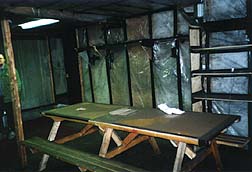 Lawrence Attic (9 April 1999): Leftist and I were taking the subway home from an evening of exploring and he asked me to show him the "attic" area above Lawrence Station. So we got off the train at Lawrence and waited around for the platform to clear, but I noticed that these two other guys, dressed in black, had ignored both the northbound and the southbound trains. I mentioned to Leftist that if it wasn't so far-fetched an idea I'd think they were planning on heading into the tunnels too. We stood near them and Leftist eavesdropped on their conversation a bit and then reported to me, "Yep, they're going." So after the next northbound train left the platform we started heading towards the Do Not Enter gates, and as we passed the two guys, I said casually, "You guys coming?" They sort of looked at each other confused for a second and then joined us. The four of us then had a fun trip into the attic, and even discovered some bizarre uncharted bits (rooms containing picnic tables and showers, for some reason) behind a door that had always been locked on previous expeditions.
Lawrence Attic (9 April 1999): Leftist and I were taking the subway home from an evening of exploring and he asked me to show him the "attic" area above Lawrence Station. So we got off the train at Lawrence and waited around for the platform to clear, but I noticed that these two other guys, dressed in black, had ignored both the northbound and the southbound trains. I mentioned to Leftist that if it wasn't so far-fetched an idea I'd think they were planning on heading into the tunnels too. We stood near them and Leftist eavesdropped on their conversation a bit and then reported to me, "Yep, they're going." So after the next northbound train left the platform we started heading towards the Do Not Enter gates, and as we passed the two guys, I said casually, "You guys coming?" They sort of looked at each other confused for a second and then joined us. The four of us then had a fun trip into the attic, and even discovered some bizarre uncharted bits (rooms containing picnic tables and showers, for some reason) behind a door that had always been locked on previous expeditions.
One of the fellows introduced himself as Pyroartist and invited me to come draining with him in the near future. I told him I'd take him up on that.
 Central Tech steam tunnels (14 April 1999): I'd heard lots of lovely rumours about the basements of Central Tech, an immense, castle-like high school in western Toronto. Some of its students believed the basement contained an Olympic-sized pool and a rifle range, and obviously I was very eager to find out the truth. After a few preliminary trips, I found an easy entrance into the steam tunnels (e-mail me for details). The tunnels are temperate and wide, but unfortunately they are quite uncomfortable due to the very low ceilings and the abundance of low-hanging pipes and vents. I toured around for around half an hour, coming across some high voltage rooms, some interesting storage areas filled with old desks and chairs, a small underground lake, an easy entrance into the school's very large ventilation shafts, and a ladder down to a lower level. When I saw the ladder to the lower level, I knew I had to call my friend Renee to come and join me, but unfortunately just after I had exited the tunnels and propped a door to the system open, a janitor walked by and closed the door properly. So I'll have to go back down and check out the second underground level another time.
Central Tech steam tunnels (14 April 1999): I'd heard lots of lovely rumours about the basements of Central Tech, an immense, castle-like high school in western Toronto. Some of its students believed the basement contained an Olympic-sized pool and a rifle range, and obviously I was very eager to find out the truth. After a few preliminary trips, I found an easy entrance into the steam tunnels (e-mail me for details). The tunnels are temperate and wide, but unfortunately they are quite uncomfortable due to the very low ceilings and the abundance of low-hanging pipes and vents. I toured around for around half an hour, coming across some high voltage rooms, some interesting storage areas filled with old desks and chairs, a small underground lake, an easy entrance into the school's very large ventilation shafts, and a ladder down to a lower level. When I saw the ladder to the lower level, I knew I had to call my friend Renee to come and join me, but unfortunately just after I had exited the tunnels and propped a door to the system open, a janitor walked by and closed the door properly. So I'll have to go back down and check out the second underground level another time.
 Merchandise Building (21 April 1999): The old Sears warehouse at the corner of Dalhousie and Dundas (Toronto) is still in the a strange netherworld between being a delicious industrial relic and a bunch of yuppie lofts. Scumbone and I went to check on its progress, and found an amazingly easy entrance to the building on the first floor. After surveying the relatively unimproved first floor and basement, we wandered up the stairs to examine the southwest portion of floors 2-6, which haven't yet been connected to the rest of the building. Lots of things have been torn down in this area but no building seems to have started yet.
Merchandise Building (21 April 1999): The old Sears warehouse at the corner of Dalhousie and Dundas (Toronto) is still in the a strange netherworld between being a delicious industrial relic and a bunch of yuppie lofts. Scumbone and I went to check on its progress, and found an amazingly easy entrance to the building on the first floor. After surveying the relatively unimproved first floor and basement, we wandered up the stairs to examine the southwest portion of floors 2-6, which haven't yet been connected to the rest of the building. Lots of things have been torn down in this area but no building seems to have started yet.
After we'd had our fill, we strolled back down to the first floor. Peering around the corner at the bottom of the stairs, I saw a security guard waving a flashlight around. "We're caught," I mumbled to Scumbone, who giggled, not realizing that I was serious until I put my finger to my lips. As it turned out, the guard seemed to be just doing his rounds and not looking for us, as Scumbone and I were able to escape from the building undetected after hiding out on a higher floor for 10 minutes or so.
Festival Hall (23 April 1999): Festival Hall is a city-block-sized retail/entertainment complex that's been under construction in downtown Toronto, scheduled for completion in May 1999. Earlier scouting had shown that the construction crews kept late hours, so Scumbone and I didn't show up until around midnight on a Friday night. Strolling around the perimeter of the building, we found a wooden barricade with a door in it. Though the door handle seemed to be fastened tight with a deadbolt, this turned out to be nothing more than a bit of decoration. We opened the door and walked through onto the site. We found four exit doors, without handles, and I reached down to the base of one of the doors to pull it out towards us.
We found ourselves at the base of a well-lit concrete stairwell, where two separate stairways criss-crossed like double-helixes as they reached up towards the top of the building. We very quietly made our way up to the top of the concrete stairway and through a couple of doors. We emerged underneath the big white screen at the front of one of the large movie theatres. Looking up at the hundreds of plush blue stadium seats, I noted that in very back corner of the theatre a security guard was sitting in one of the chairs! We were very clearly trespassing, and directly in his line of vision... except that his eyelids were closed! I grabbed a quick picture of the napping guard and then Scumbone and I beat a hasty retreat to a different level of the building.
 As Scumbone and I strolled around the top floor of the building in search of stairs up to the roof, we came across a little electrical room humming with high voltage. A metal ladder here stretched two storeys up to a roof hatch which I quickly found myself on the opposite side of. The multiple levels of the gravel-coated roof were all extremely dark, so I had to be careful not to look out at the bright lights of the city or I'd spoil my night vision and presumably topple to my death. After looking around for a bit and taking a picture of Festival Hall's distinctive rainbow cube from the edge of the roof, I climbed back down into the electrical room. As Scumbone and I strolled around the top floor of the building in search of stairs up to the roof, we came across a little electrical room humming with high voltage. A metal ladder here stretched two storeys up to a roof hatch which I quickly found myself on the opposite side of. The multiple levels of the gravel-coated roof were all extremely dark, so I had to be careful not to look out at the bright lights of the city or I'd spoil my night vision and presumably topple to my death. After looking around for a bit and taking a picture of Festival Hall's distinctive rainbow cube from the edge of the roof, I climbed back down into the electrical room.
Emerging back into the main hallway, we were surprised to hear the sounds of someone working nearby. We dashed for a stairway heading down, and we happened to pick a set of stairs that only exited to the area outside the building but still inside the tall wooden barricades. I pulled open another door to reveal a stairway leading down, and so we descended to the bottom of the building, emerging three levels underground inside a parking garage. We then wandered up the ramps of the parking garage in search of another entrance to the main floor of the building. On the P1 level, we found an unmanned security office containing 20-or-so CCTV monitors and after this we felt much more relaxed about wandering in front of security cameras. We didn't find a route directly from the parking garages to the main floor, but after exiting the building we found a handleless but unlocked door leading directly from Richmond Street to the main level of the site. We wandered the mostly unfinished lower two floors of the building for some time finding some employee graffiti, a freight elevator, the garage for the construction vehicles and the workers' lunchroom before eventually calling it a night and exiting through the same door we'd come in.
 Buffalo Central Terminal (1 May 1999): Scumbone and I crossed the border to Buffalo for a visit to the no-longer-abandoned town of Love Canal and an investigation of the Buffalo Central Terminal (which I described in depth in February). There were a fair number of new features at the BCT, including an eight-foot-tall chain link fence around the perimeter of the main building and thick wooden barricades between each floor of the freight terminal and the main building.
Buffalo Central Terminal (1 May 1999): Scumbone and I crossed the border to Buffalo for a visit to the no-longer-abandoned town of Love Canal and an investigation of the Buffalo Central Terminal (which I described in depth in February). There were a fair number of new features at the BCT, including an eight-foot-tall chain link fence around the perimeter of the main building and thick wooden barricades between each floor of the freight terminal and the main building.
Fortunately, I remembered from my last visit that the roof of the freight building leads to a lovely little hole in the outside wall of the main building, so Scumbone and I had no trouble getting inside and taking the full tour of the abandoned offices, the 20-storey-high roof, the great hall and the flooded basement levels. The basements were now filled with water instead of ice, so we weren't able to crawl around some of the interesting half-flooded rooms.
We spent most of the afternoon touring the joint. When we reemerged late in the day, we were horrified to see the windows on Scumbone's car had been smashed and her hood left propped open. Nothing had been stolen, as there was nothing worth stealing, but we had to notify the Buffalo police anyhow. An officer came out and met us at the BCT. At first he seemed more concerned with why we were at the building than with our misfortune. I explained that we'd just been wandering around the site for a while, and had taken a quick look inside.
"You went inside the building?" he asked. "That's trespassing!"
"There were no signs," I replied, "so we just took a quick look. It's such a beautiful building that we couldn't resist."
"Well, I'll notify them [ed.: who?] that the site has become unsecure."
This last comment of the officer's is quite funny, if you know the place. There are at least three dozen easy entrances to the building at a variety of points. They won't be able to seal it up, so feel free to visit (but be sure to park your car somewhere near civilization).
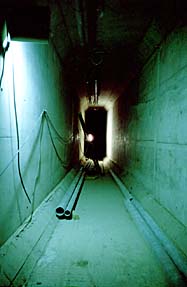 Sheppard subway construction (several occasions 1999): A few final explorations and photo shoots had to be done under Sheppard Avenue this month to allow me to finish Infiltration 13. The highlight of the entire Sheppard Subway line experience occurred at about 2a.m. one Friday night when Scumbone and I managed to sneak past some workers into the tube tunnels at Leslie and hike all the way to the end of the line, eventually popping up in the middle of Sheppard Avenue a few paces to the east of Yonge Street.
Sheppard subway construction (several occasions 1999): A few final explorations and photo shoots had to be done under Sheppard Avenue this month to allow me to finish Infiltration 13. The highlight of the entire Sheppard Subway line experience occurred at about 2a.m. one Friday night when Scumbone and I managed to sneak past some workers into the tube tunnels at Leslie and hike all the way to the end of the line, eventually popping up in the middle of Sheppard Avenue a few paces to the east of Yonge Street.
Towards the end of the month, I took a tourist from Ottawa down into the series of gigantic cement chambers area that will eventually blosson into Leslie station. The station is now all but connected to both the tube tunnels leading towards Yonge Street and the cut and cover tunnels leading towards Don Mills Avenue. Still no sign of any security whatsoever!
Eaton Centre (early May 1999): Scumbone and I journeyed to Toronto's most popular tourist attraction with the intention of exploring the exciting new construction on both the east and west flanks of the building. A construction worker kicked us out while we were looking around the west side (which seems to be where the real action is), so we settled for the far less interesting east side. Gaining entry was a simple matter of peeling back a wooden barricade, and then we had full run of two levels of raw concrete and drywall. Unfortunately, it seems they're just adding a few new shops, so there was nothing architecturally fascinating to peek at.
For dessert, we headed into the employee corridors of the mall and went down to peek at the gigantic receiving bay four levels under, as well as the underground highway that serves it. It is an impressive sight, though not deserving of the "underground city" appellation I've heard a few people give it.
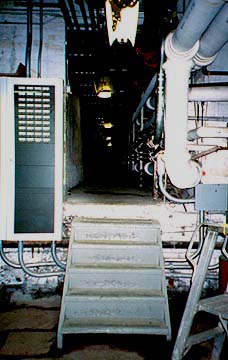 University of Toronto (late May 1999): I can't find any past or present students of the University of Toronto who will give me good leads about where to find steam tunnels on the UofT campus. Why so secretive? Naturally, I suspect alien involvement.
University of Toronto (late May 1999): I can't find any past or present students of the University of Toronto who will give me good leads about where to find steam tunnels on the UofT campus. Why so secretive? Naturally, I suspect alien involvement.
In any case, in May I decided to take matters into my own hands and find the damn tunnels myself, even though I don't know anything about the layout of the UofT campus and the prospect of investigating the basements of more than a hundred buildings scattered around the city is a little bit daunting. On the first expedition, Scumbone and I did indeed manage to find a good solid set of steam tunnels under Trinity College. Though quite cool and well-lit, these tunnels had a good deal of character, with multiple levels, red brick walls in places, and lots of ridiculous signage and graffiti.
Park Drive Drain (30 June 1999): Persephone and I arranged to investigate the mammoth drain emptying out at Toronto's Park Drive Reservation with Pyroartist and his friend Matt. It was... memorable.
After Pyro used his car jack to lift up the incredibly heavy entrance to the drain, we posed for a couple of commemorative pictures (which I'm going to get from the bastard one of these days) and hopped inside the drain, which is considerably larger than any drain any of us has ever seen. After a while, we came to our first "waterfall chamber": a gigantic underground room (by Canadian standards, at least) where torrents of water plunged down toward us from another pipe, and where the floor was perforated with several deep water pits which would certainly make for a cold and unpleasant swim. Happily, a metal ladder and catwalk had been supplied to help us ascend from the the waterfall chamber to the upper pipe. Unhappily, some past flood had washed the catwalk away, leaving only the frame. So we climbed the ladder and carefully made our way along the frame to the new pipe. Twenty minutes later, we did the same again at the next waterfall chamber.
As we started to approach the third waterfall chamber, we came upon some ladders leading up to a manhole, and Pyro decided he wanted to take a peek outside and see how far up the drain we'd travelled, so he, Matt and I climbed up five or six storeys and attempted to push off the manhole cover. It wasn't budging, so we concluded it was bolted from the outside.
Most people probably would've given up at that point, but Pyro was stubborn to the point of obsession, and he recruited first Matt then myself into helping him push at the cover for about 40 minutes, and continued to push it alone after Matt and I had given up. The rest of us were cold and bored and fed up, and I suggested to Pyro that he give up. He only replied that there was absolutely no way he was leaving until he pried the cover loose. At that point, I thought about taking off with Persephone (and Matt, if he wanted), but the four of us only had two decent flashlights between us, and Pyro's had been working unreliably since he'd dropped it in the water earlier, so I couldn't bring myself to leave.
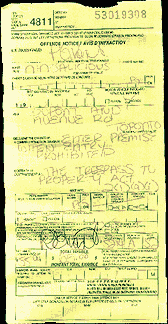 On the other hand, we'd been in the same spot in the drain for about an hour now, and I couldn't bring myself to stay there any longer, so Persephone and I wandered further up the drain to peak at the next waterfall chamber. We'd only been there a few minutes when we heard extremely loud yelling from further back. We rushed back and found Matt, who told us jubilantly that Pyro had finally removed the cover and was now waiting for us to come join him on the surface! We raced to the surface and popped out of the manhole, joining Pyro in a small parkette in northern Toronto.
On the other hand, we'd been in the same spot in the drain for about an hour now, and I couldn't bring myself to stay there any longer, so Persephone and I wandered further up the drain to peak at the next waterfall chamber. We'd only been there a few minutes when we heard extremely loud yelling from further back. We rushed back and found Matt, who told us jubilantly that Pyro had finally removed the cover and was now waiting for us to come join him on the surface! We raced to the surface and popped out of the manhole, joining Pyro in a small parkette in northern Toronto.
As we merrily changed our footwear, all was jubilantly forgiven and forgotten. Pyro was thrilled to have triumphed over the manhole cover; Persephone, Matt and I were thrilled to not have to spend the rest of our lives hearing the phrase "five more minutes". We were all thrilled to have had a successful expedition.
That's when the cops walked up. One friendly male Canadian Pacific cop, two rather humourless female city cops. "How long have you been down there? Days? Weeks?" asked the CP cop. "No, just a couple of hours," Matt replied. "Well, I heard a lot of yelling down there while I was passing through the area," he explained as he collected our ID, "so I called these officers. They're going to decide what to do with you. It may be just a warning, or it may be a ticket for trespassing." I did my best to seem humble and contrite and poor, but eventually the police decided to give us each a $65 ticket for trespassing (an offence they had to look up, and for which they had to modify a parking ticket). A perfect end to a perfect evening.
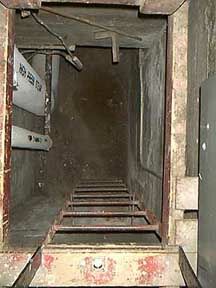 University of Toronto steam tunnels (early July 1999): My pal James kindly offered to show me a small stretch of the tunnels under the UofT, so we met up in the early evening and took the plunge. The entrance, located near the northwestern end of the campus, consists of a wooden trapdoor in the floor leading down to a ladder. Very odd. The tunnels and subterranean rooms beyond were not extensive by any means, but they did have a wonderfully ancient and unused quality. We spent about 30 minutes poking around before coming to the spot where a firmly locked steel grate ends any hope of proceeding further south.
University of Toronto steam tunnels (early July 1999): My pal James kindly offered to show me a small stretch of the tunnels under the UofT, so we met up in the early evening and took the plunge. The entrance, located near the northwestern end of the campus, consists of a wooden trapdoor in the floor leading down to a ladder. Very odd. The tunnels and subterranean rooms beyond were not extensive by any means, but they did have a wonderfully ancient and unused quality. We spent about 30 minutes poking around before coming to the spot where a firmly locked steel grate ends any hope of proceeding further south.
After returning to the surface, James and I grabbed a drink at a nearby pub. A friend of James said to him, "Hey James, I saw you cross the lot earlier, but I never saw you come back. Do you have some sort of secret network of tunnels or something?" James, who isn't entirely open about his hobby, just said "kind of" and changed the subject.
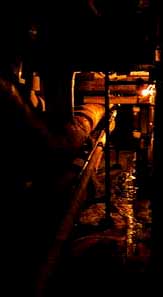 Union Station and Royal York Hotel (mid July 1999): An acquaintance and I had a ridiculously successful trip to Toronto Union Station, which I'm happy to report hasn't become any more secure since the publicity this summer. If anything, it's become more inviting to visitors. The two of us saw virtually every interesting inch of the building, from the outside on the uppermost roof, to the flooded tunnel leading between the train station and the subway station, to the full run of steam tunnels in the basement. We even managed to take the steam tunnels all the way to the sub-sub-basement of the Royal York hotel! (I've made this trip once before, but the last time I did it I didn't realize what I'd found, so I wasn't able to fully appreciate it.)
Union Station and Royal York Hotel (mid July 1999): An acquaintance and I had a ridiculously successful trip to Toronto Union Station, which I'm happy to report hasn't become any more secure since the publicity this summer. If anything, it's become more inviting to visitors. The two of us saw virtually every interesting inch of the building, from the outside on the uppermost roof, to the flooded tunnel leading between the train station and the subway station, to the full run of steam tunnels in the basement. We even managed to take the steam tunnels all the way to the sub-sub-basement of the Royal York hotel! (I've made this trip once before, but the last time I did it I didn't realize what I'd found, so I wasn't able to fully appreciate it.)
Though scarcely a single locked door stood in our way this trip, we did have a couple of close calls involving almost unbearably long and silent waits for employees to get out of our way. After one such close call in the mechanical rooms of the Royal York, we followed the tunnels through Union Station as far south as they'd take us, eventually coming upon a brand new section at the southernmost end of the system. We popped up and out of the sidewalk here, and had just snapped the grate locked behind us when we realized we were inside a fenced-in construction area with a traffic cop working busily not 20 feet away. Luckily her eye was on her job so we managed to scale the fence and leave the area without incident.
Edgar Occupational Centre (late July 1999): Scumbone received word about the Edgar Occupational Centre from her mother. A visit to an abandoned psychiatric facility (euphemistically named an "occupational centre") sounded perfect for the fear-themed Infiltration 14, so I persuaded Scumbone to spend several hours driving us out to the distant rural community of Edgar so we could drop in.
After much searching, we found the joint, parked Scumbone's car by the side of the road and snuck onto the lot through the woods so as to avoid the security guard at the front gate. I'd been expecting an ancient, ominous brick structure, but what we found was creepy in a radically different way. What Edgar called an occupational centre was a very large, entirely abandoned community for crazy people, featuring more than a hundred homes, schools, community centres, recreation facilities and the like. Except for the uncut lawns, the slightly unkept look to the buildings, and the lack of people and cars, it looked just like a regular suburban subdivision.
Something about the place was very creepy to me; maybe it was the need to travel in well-lit open spaces with a security guard nearby, or maybe it was the post-neutron bomb feel of the area. The whole place had been extremely well-maintained since being abandoned, and with every door was locked and every window intact there really wasn't much exploring to do, so I convinced Scumbone that we should call it an early day.
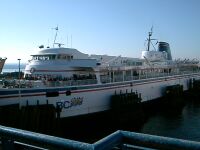 BC Ferries Spirit of Esquimalt (2 October 1999): While I was visiting my former homeland of British Columbia, I got a bit nostalgic for one of my old favourite places to explore: the big ferries that shuttle cars and people back and forth between Vancouver and Victoria. My family had always been fond of taking trips to Victoria, and during the four-hour round trip to the island I'd quickly learned that exploring the ship was both cheaper and more thrilling than pumping steady streams of quarters into Tutankamen and Bagman.
BC Ferries Spirit of Esquimalt (2 October 1999): While I was visiting my former homeland of British Columbia, I got a bit nostalgic for one of my old favourite places to explore: the big ferries that shuttle cars and people back and forth between Vancouver and Victoria. My family had always been fond of taking trips to Victoria, and during the four-hour round trip to the island I'd quickly learned that exploring the ship was both cheaper and more thrilling than pumping steady streams of quarters into Tutankamen and Bagman.
I was really feeling more nostalgic about exploring the ferries than about visiting Victoria, so my plan was to pay the $8.50 fare to travel over to the island and then hide somewhere when the time came to disembark, so I wouldn't have to pay a further $8.50 to come back. I thought being a stowaway during the trip back would be pretty cool.
I purchased my one-way ticket at the Tsawwassen ferry terminal more than two hours ahead of the next scheduled departure, so to kill time I wandered down to the ferry docks to take some pictures. As I was doing so, I couldn't help but notice that the car ramp leading to the ferry in dock two, the Spirit of Esquimalt, was down. I was pretty sure I'd soon be shoo'ed away from the area, but I figured it couldn't do any harm to wander up the car ramp and take a couple of pictures of the ferry's main loading bay before I was evicted.
Once I got away with that I figured it couldn't do any harm if I just casually walked inside.
Once I got away with that I figured it couldn't do any harm if I just strolled along the length of the ferry and took some pictures from the ship's prow.
And once I got away with that I began to realize that I had the whole ship to myself and could do whatever I wanted.
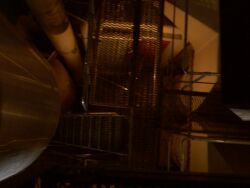 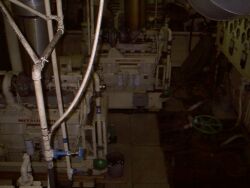
The view down from five flights above sea level, and some engine rooms two flights below sea level.
 Buffalo Central Terminal (27 November 1999): Scumbone and I travelled to Buffalo, hoping to explore both the city hall and the BCT. As it happened, City Hall was locked up securely for the weekend, but when we drove to the neighbourhood of the Buffalo Central Terminal we were surprised to see that the four faces of the clock tower were lit up and functioning with the correct time!
Buffalo Central Terminal (27 November 1999): Scumbone and I travelled to Buffalo, hoping to explore both the city hall and the BCT. As it happened, City Hall was locked up securely for the weekend, but when we drove to the neighbourhood of the Buffalo Central Terminal we were surprised to see that the four faces of the clock tower were lit up and functioning with the correct time!
Obviously, we were very eager to get in and take a peek at whatever restoration had taken place, but sadly, the city had recently installed very sturdy barriers between all passages from the side building (which, apparently, Buffalo has abandoned all hope of keeping people out of) into the Great Hall. So, though we were able to roam the side building quite freely, we were unable to get anywhere near the clock before intense coldness and encroaching darkness made us give up. This just made us determined to come back again soon.

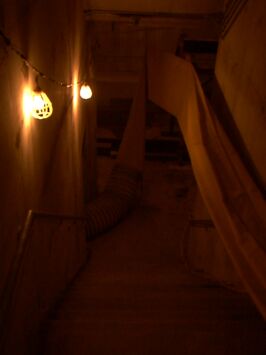
Western Sheppard Line tunnels (5 December 1999): I somehow got talked into letting a writer and a photographer from the late magazine Details accompany me to the western expanses of the under-construction Sheppard subway tunnels. As a general rule I hate men's magazines, and have told writers from Maxim and Stuff to go to hell, but this fellow from Details had some good infiltrating stories and offered to buy me some seafood. So after digesting the food and looking around Lawrence station a bit, we toured some exciting just-born tunnels and spaces a little to the west of Sheppard. The article ran in the final issue of Details.
 Hamilton Harbour (6 December 1999): Scumbone and I took a little road trip to the industrial wonderland that is Hamilton, Ontario, in the hope of boarding some boats and having some high-seas hijinks. In spite of it being cold and rainy, we had a pretty great day of journeying around the heavily industrialized harbour, which is nothing but trains, trucks, ships and factories working hard to convert the ubiquitous huge piles of raw materials into replicas of themselves.
Hamilton Harbour (6 December 1999): Scumbone and I took a little road trip to the industrial wonderland that is Hamilton, Ontario, in the hope of boarding some boats and having some high-seas hijinks. In spite of it being cold and rainy, we had a pretty great day of journeying around the heavily industrialized harbour, which is nothing but trains, trucks, ships and factories working hard to convert the ubiquitous huge piles of raw materials into replicas of themselves.
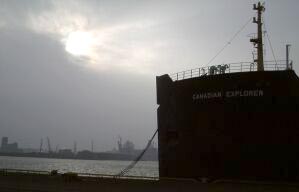 We failed to board the very impressive cargo ship Pintail, but did have some luck on some smaller ships and tugboats. We also came across a decommissioned titan of a ship called the Canadian Explorer, which we figured was named after us. The ship wasn't carrying any cargo, so it was obviously much higher in the water than usual. I climbed a long way up a far-too-flimsy rope ladder leading up from the icy, toxic lake in order to take a peek on deck -- when I did, I saw that the ship was being gutted for scrap metal and parts.
We failed to board the very impressive cargo ship Pintail, but did have some luck on some smaller ships and tugboats. We also came across a decommissioned titan of a ship called the Canadian Explorer, which we figured was named after us. The ship wasn't carrying any cargo, so it was obviously much higher in the water than usual. I climbed a long way up a far-too-flimsy rope ladder leading up from the icy, toxic lake in order to take a peek on deck -- when I did, I saw that the ship was being gutted for scrap metal and parts.
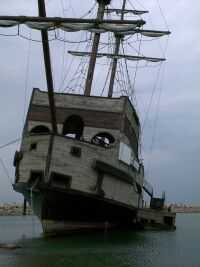 La Grande Hermine (19 December 1999): Liz, Scumbone and I journeyed to St. Catharines, Ontario, and managed a very successful and memorable dinghy expedition to board a half-sunken ship called La Grande Hermine.
La Grande Hermine (19 December 1999): Liz, Scumbone and I journeyed to St. Catharines, Ontario, and managed a very successful and memorable dinghy expedition to board a half-sunken ship called La Grande Hermine.
We headed to the Hermine's cove equipped with a pre-inflated Explorer 100 raft with a carrying capacity of 120 pounds. None of us weighed a mere 120 pounds, of course, but the raft had only cost $18 and I figured it would stay more-or-less afloat long enough to get us aboard. My companions were less sure of this, so I was given the honour of making the first journey. Armed with a flashlight, a camera, a rope and a couple of small boards to be used in place of oars, I lowered myself into the raft and headed out to sea....
All the horror and ecstacy that followed are recounted in Infiltration 15: Infiltration at Sea.
Location Index | Onward to 2000!

 The full, paper version of Infiltration can be ordered for $2 cash (US or Cnd) from Infiltration, PO Box 13, Station E, Toronto, Ontario, M6H 4E1, Canada.
Please toss any comments, queries or contributions to Ninjalicious.
The full, paper version of Infiltration can be ordered for $2 cash (US or Cnd) from Infiltration, PO Box 13, Station E, Toronto, Ontario, M6H 4E1, Canada.
Please toss any comments, queries or contributions to Ninjalicious.
|









 Sheppard Subway Construction Site (19 February 1999): It was about 8p.m. and I'd finished visiting a friend at Yonge and Sheppard (Toronto). I noticed that the normally teeming construction site was completely unpopulated. I wasn't dressed for it or equipped with a proper flashlight, but I couldn't really resist, so I pulled back a flimsy rubber fence and slid through. I waded through the soggy mud until I found a slope leading down into the pit. I slipped and slid most of the way down, but climbed down a few ladders as well where these were provided.
Sheppard Subway Construction Site (19 February 1999): It was about 8p.m. and I'd finished visiting a friend at Yonge and Sheppard (Toronto). I noticed that the normally teeming construction site was completely unpopulated. I wasn't dressed for it or equipped with a proper flashlight, but I couldn't really resist, so I pulled back a flimsy rubber fence and slid through. I waded through the soggy mud until I found a slope leading down into the pit. I slipped and slid most of the way down, but climbed down a few ladders as well where these were provided. 
 Brock University Steam Tunnels (20 February 1999): I visited Brock University (St. Catharines, Ontario) with those documentary people. We arrived on campus around noon, and were ushered into the tunnel system by a friendly physical plant guy, who pretty much just let us inside and then took off for the day.
Brock University Steam Tunnels (20 February 1999): I visited Brock University (St. Catharines, Ontario) with those documentary people. We arrived on campus around noon, and were ushered into the tunnel system by a friendly physical plant guy, who pretty much just let us inside and then took off for the day. Buffalo Central Terminal (27 February 1999): I went to check out the abandoned Buffalo (New York) Central Terminal with the documentary people and Lefty and L.B. of
Buffalo Central Terminal (27 February 1999): I went to check out the abandoned Buffalo (New York) Central Terminal with the documentary people and Lefty and L.B. of  I led my half of the crew back outside and into a long, low building that,
it seemed to me, had served freight trains rather than passenger trains. I
explored several rooms, including unlit storage rooms and extremely
vandalized washrooms, before finding a tall metal ladder leading up. I
clambered up into a very tempting dark hallway where much of the roof had
collapsed onto the floor, and then had to wait impatiently for the film crew
to catch up. We then walked around the top of the building on a catwalk,
which was fun, though I sensed that the people lugging the heavy equipment
up and down the ladders were enjoying all the multi-level action less than I
was.
I led my half of the crew back outside and into a long, low building that,
it seemed to me, had served freight trains rather than passenger trains. I
explored several rooms, including unlit storage rooms and extremely
vandalized washrooms, before finding a tall metal ladder leading up. I
clambered up into a very tempting dark hallway where much of the roof had
collapsed onto the floor, and then had to wait impatiently for the film crew
to catch up. We then walked around the top of the building on a catwalk,
which was fun, though I sensed that the people lugging the heavy equipment
up and down the ladders were enjoying all the multi-level action less than I
was. We crossed down to the second storey and did more general tourism. Among the
more memorable sights we took in were a flooded, frozen library filled with
record books and ancient frozen typewriters, an open but empty safe, some
open elevator shafts and several different flights of stairs leading up. We
gradually made our way up the main tower, stopping every couple of floors to
investigate the abandoned offices on a particular level. Some were covered
in charred record books, while others were surprisingly clean. Record books
were in abundance throughout the building; one stairwell we took was coated
with several feet of old record books that we had to climb on top of. We
found the elevators hanging suspended in the shaft on the 9th floor; then
five or six floors higher we stumbled upon the huge clocks that once
broadcasted the time to all of suburban Buffalo. Most of the gears were gone
but the glass-and-iron clock faces were still more or less intact.
We crossed down to the second storey and did more general tourism. Among the
more memorable sights we took in were a flooded, frozen library filled with
record books and ancient frozen typewriters, an open but empty safe, some
open elevator shafts and several different flights of stairs leading up. We
gradually made our way up the main tower, stopping every couple of floors to
investigate the abandoned offices on a particular level. Some were covered
in charred record books, while others were surprisingly clean. Record books
were in abundance throughout the building; one stairwell we took was coated
with several feet of old record books that we had to climb on top of. We
found the elevators hanging suspended in the shaft on the 9th floor; then
five or six floors higher we stumbled upon the huge clocks that once
broadcasted the time to all of suburban Buffalo. Most of the gears were gone
but the glass-and-iron clock faces were still more or less intact. After a little more exploring of the upper levels, we had to head back down
to meet with the other crew. We were setting up for an interview in the
great hall when a couple in their 50s walked in and said hello. The producer
mentioned that we were filming a documentary, and the couple offered to
leave, but we encouraged them to stay and have a look around. They explained
that they were just back visiting for the memories. The terminal had been
where the man had shipped off to the Korean War, and it was even more
significant to the woman, whose first husband had been killed in an accident
while working there as a mechanic decades ago. The man talked about how
they'd just been to Toronto and it seemed so big and prosperous that it made
them sad for Buffalo, which had once seemed to be a city poised for
greatness. They reminisced at length about how the great hall had once been
continuously filled with thousands of people, and dozens of busy shops and
restaurants. The man explained that it had always been kept immaculate:
never a ticket or even a cigarette ash on the floor. The woman interjected
that they had always dressed up in their Sunday best before coming to the
train station. The man told us that all the floors had been made out of
polished marble. We scraped off a few centimeters of dirt with our shoes and
showed him that it still was, and I told him that it was still a beautiful
building. They shook our hands, wandered around a bit more and then left.
After a little more exploring of the upper levels, we had to head back down
to meet with the other crew. We were setting up for an interview in the
great hall when a couple in their 50s walked in and said hello. The producer
mentioned that we were filming a documentary, and the couple offered to
leave, but we encouraged them to stay and have a look around. They explained
that they were just back visiting for the memories. The terminal had been
where the man had shipped off to the Korean War, and it was even more
significant to the woman, whose first husband had been killed in an accident
while working there as a mechanic decades ago. The man talked about how
they'd just been to Toronto and it seemed so big and prosperous that it made
them sad for Buffalo, which had once seemed to be a city poised for
greatness. They reminisced at length about how the great hall had once been
continuously filled with thousands of people, and dozens of busy shops and
restaurants. The man explained that it had always been kept immaculate:
never a ticket or even a cigarette ash on the floor. The woman interjected
that they had always dressed up in their Sunday best before coming to the
train station. The man told us that all the floors had been made out of
polished marble. We scraped off a few centimeters of dirt with our shoes and
showed him that it still was, and I told him that it was still a beautiful
building. They shook our hands, wandered around a bit more and then left. Shortly after this, we wandered outside, into a back alley behind the
station, where we met up with two guys in their 20s who were taking
pictures. They asked us about what the inside of the station was like, and
told us they were taking pictures for a contest a Buffalo art gallery was
having called “images of the Buffalo Central Terminal” or something. They’d
neglected to bring flashlights, though, so they wouldn't have gotten far
inside the building. After a bit of poking around inside the building on the
other side of the alley, a police car cruised by us really slowly on the
other side of a cement wall. The cops obviously wanted us to come over and
explain ourselves, but we didn't feel like it, and they didn't feel like
getting out of their car, so it was a stalemate. We invited the
photographers to come with us back inside the building, and we showed them
some of the more impressive sights we'd seen in the subbasements, like the
corridor containing a car stripped bare, a big subterranean reception hall
of some sort, and cement walls erected halfway up ornate staircases.
Shortly after this, we wandered outside, into a back alley behind the
station, where we met up with two guys in their 20s who were taking
pictures. They asked us about what the inside of the station was like, and
told us they were taking pictures for a contest a Buffalo art gallery was
having called “images of the Buffalo Central Terminal” or something. They’d
neglected to bring flashlights, though, so they wouldn't have gotten far
inside the building. After a bit of poking around inside the building on the
other side of the alley, a police car cruised by us really slowly on the
other side of a cement wall. The cops obviously wanted us to come over and
explain ourselves, but we didn't feel like it, and they didn't feel like
getting out of their car, so it was a stalemate. We invited the
photographers to come with us back inside the building, and we showed them
some of the more impressive sights we'd seen in the subbasements, like the
corridor containing a car stripped bare, a big subterranean reception hall
of some sort, and cement walls erected halfway up ornate staircases.  Masonic Temple/Concert Hall (19 March 1999): Around two and a half years ago, I took my first in-depth look behind the scenes at the Masonic Temple/Concert Hall at Yonge and Davenport (Toronto). The occasion was the fifth anniversary party of
Exclaim magazine. I went for the zine show, but that turned out to be really small and pathetic so some friends and I quickly turned our attention to the very old, very lovely building we were in, which was built by the Masons many decades ago, but later became one of Toronto's main concert venues. Security was terrible, so we managed to get several floors underground to the deepest subbasements, into huge darkened concert halls, into old abandoned-looking kitchens, storage rooms and changerooms, and even through an elevator room and out onto the roof. We had a great time, even hooking up with another small group of explorers (who tried posing as security guards until they found themselves unable to keep straight faes).
Masonic Temple/Concert Hall (19 March 1999): Around two and a half years ago, I took my first in-depth look behind the scenes at the Masonic Temple/Concert Hall at Yonge and Davenport (Toronto). The occasion was the fifth anniversary party of
Exclaim magazine. I went for the zine show, but that turned out to be really small and pathetic so some friends and I quickly turned our attention to the very old, very lovely building we were in, which was built by the Masons many decades ago, but later became one of Toronto's main concert venues. Security was terrible, so we managed to get several floors underground to the deepest subbasements, into huge darkened concert halls, into old abandoned-looking kitchens, storage rooms and changerooms, and even through an elevator room and out onto the roof. We had a great time, even hooking up with another small group of explorers (who tried posing as security guards until they found themselves unable to keep straight faes). On a subsequent trip (at the following year's Exclaim party), Ultraviolet and I were at first thwarted by the much improved security, but eventually stumbled upon an unlocked door. Swiftly running through some unlit rooms and up a darkened staircase, we found ourselves on the 300 level (third floor up). As we continued our ascent and began touring the 400 level, we heard loud voices behind us and began to get nervous. Some guys opened a door and when they saw us said "oh sorry", and shut the door. I immediately re-opened the door and asked them what they were doing up here, and when they sheepishly (and somewhat drunkenly) told us they were just looking around, we began to trade tips.
On a subsequent trip (at the following year's Exclaim party), Ultraviolet and I were at first thwarted by the much improved security, but eventually stumbled upon an unlocked door. Swiftly running through some unlit rooms and up a darkened staircase, we found ourselves on the 300 level (third floor up). As we continued our ascent and began touring the 400 level, we heard loud voices behind us and began to get nervous. Some guys opened a door and when they saw us said "oh sorry", and shut the door. I immediately re-opened the door and asked them what they were doing up here, and when they sheepishly (and somewhat drunkenly) told us they were just looking around, we began to trade tips. Our new tour guides led us up to the 600-level to show us what they called the gallery: a mezzanine looking down on a huge, sunken ceremonial hall for the masons. This place was very dimly lit and very creepy, and our guides quickly took off, telling us they were off in search of the coffins. Ultraviolet and I were fascinated by the evil feel of the place, though, and took some stairs down to get a closer look. The walls and chairs were dark, ornately carved wood, and the carpets, lighting and upholstery were all deep, blood red, creating what must've been a deliberately Satanic atmosphere. A series of tall wooden thrones rested on an elevated platform at the centre of the room, underneath the obligatory wooden carving of the eye in the pyramid. Though chilled by the atmosphere and the constant loud creaking and echoes in this part of the building, we toured behind and above the scenes by the light of a pocket flashlight, exploring old lockers that seemed to have been ransacked some time ago.
Our new tour guides led us up to the 600-level to show us what they called the gallery: a mezzanine looking down on a huge, sunken ceremonial hall for the masons. This place was very dimly lit and very creepy, and our guides quickly took off, telling us they were off in search of the coffins. Ultraviolet and I were fascinated by the evil feel of the place, though, and took some stairs down to get a closer look. The walls and chairs were dark, ornately carved wood, and the carpets, lighting and upholstery were all deep, blood red, creating what must've been a deliberately Satanic atmosphere. A series of tall wooden thrones rested on an elevated platform at the centre of the room, underneath the obligatory wooden carving of the eye in the pyramid. Though chilled by the atmosphere and the constant loud creaking and echoes in this part of the building, we toured behind and above the scenes by the light of a pocket flashlight, exploring old lockers that seemed to have been ransacked some time ago. In another completely unlit area, we found what seemed to be a prop room, filled with many old props, some of which seemed to be for masonic ceremonies, such as candles, robes and lamps, and some of which can only have been for plays, such as military camouflage and costumes. We also found a sheet glued to the inside door of a wardrobe describing the positions of the different levels of masons and the decorations to which each was entitled. This floor was very creepy, so we were glad to leave it in search of the roof.
In another completely unlit area, we found what seemed to be a prop room, filled with many old props, some of which seemed to be for masonic ceremonies, such as candles, robes and lamps, and some of which can only have been for plays, such as military camouflage and costumes. We also found a sheet glued to the inside door of a wardrobe describing the positions of the different levels of masons and the decorations to which each was entitled. This floor was very creepy, so we were glad to leave it in search of the roof. After meeting up with Leftist and his friend Sara at Fairview Mall, I lead them to the oversized viewing hole I'd used the week before and coaxed them through. We descended the seven storeys into the pit and I showed them around a bit. After peaking in on the blueprints, we continued to the west, crossing under the wooden boards supporting all the traffic on Don Mills seven storeys above.
After meeting up with Leftist and his friend Sara at Fairview Mall, I lead them to the oversized viewing hole I'd used the week before and coaxed them through. We descended the seven storeys into the pit and I showed them around a bit. After peaking in on the blueprints, we continued to the west, crossing under the wooden boards supporting all the traffic on Don Mills seven storeys above. After another look at the TBM, I persuaded Leftist and Sara that we should walk down the tunnel towards Leslie. Our progress along the tracks was very slow, as the sloppy grey muck at our feet was quite deep, and there were no boards running along the side of the tunnel to make our journey easier. We'd travelled about a kilometer into the tunnel when Leftist declared that he needed a rest. While we waited, I thought I heard a voice off in the distance. Straining my eyes to see as far down the tunnel as possible, I thought I saw a vaguely humanoid figure wearing a hardhat, but I had to stare intently for several moments to determine that it was moving. I guess the worker felt my stare, because just then he started yelling at us, though we were so far away that I could barely hear his voice, let alone make out his words.
After another look at the TBM, I persuaded Leftist and Sara that we should walk down the tunnel towards Leslie. Our progress along the tracks was very slow, as the sloppy grey muck at our feet was quite deep, and there were no boards running along the side of the tunnel to make our journey easier. We'd travelled about a kilometer into the tunnel when Leftist declared that he needed a rest. While we waited, I thought I heard a voice off in the distance. Straining my eyes to see as far down the tunnel as possible, I thought I saw a vaguely humanoid figure wearing a hardhat, but I had to stare intently for several moments to determine that it was moving. I guess the worker felt my stare, because just then he started yelling at us, though we were so far away that I could barely hear his voice, let alone make out his words.  I turned around to face Leftist and Sara, who were absorbed in conversation and hadn't noticed the turn of events. In a voice that made it very clear I wasn't joking, I said "I think we should make as hasty a retreat as possible." I explained the details as we fled back up the tunnel. Sara was almost running along one rail, I was hopping from board to rail to board, and Leftist was simply trudging along through the shallow muck at the side of the tunnel. As we retreated, I took out my pocket flashlight and flashed it behind us three times, in the way that I've seen TTC workers do to one another when they spot each other from a distance inside the subway tunnels. I hoped this might confuse the workers enough to keep them from calling the police.
I turned around to face Leftist and Sara, who were absorbed in conversation and hadn't noticed the turn of events. In a voice that made it very clear I wasn't joking, I said "I think we should make as hasty a retreat as possible." I explained the details as we fled back up the tunnel. Sara was almost running along one rail, I was hopping from board to rail to board, and Leftist was simply trudging along through the shallow muck at the side of the tunnel. As we retreated, I took out my pocket flashlight and flashed it behind us three times, in the way that I've seen TTC workers do to one another when they spot each other from a distance inside the subway tunnels. I hoped this might confuse the workers enough to keep them from calling the police. Lawrence Attic (9 April 1999): Leftist and I were taking the subway home from an evening of exploring and he asked me to show him the "attic" area above Lawrence Station. So we got off the train at Lawrence and waited around for the platform to clear, but I noticed that these two other guys, dressed in black, had ignored both the northbound and the southbound trains. I mentioned to Leftist that if it wasn't so far-fetched an idea I'd think they were planning on heading into the tunnels too. We stood near them and Leftist eavesdropped on their conversation a bit and then reported to me, "Yep, they're going." So after the next northbound train left the platform we started heading towards the Do Not Enter gates, and as we passed the two guys, I said casually, "You guys coming?" They sort of looked at each other confused for a second and then joined us. The four of us then had a fun trip into the attic, and even discovered some bizarre uncharted bits (rooms containing picnic tables and showers, for some reason) behind a door that had always been locked on previous expeditions.
Lawrence Attic (9 April 1999): Leftist and I were taking the subway home from an evening of exploring and he asked me to show him the "attic" area above Lawrence Station. So we got off the train at Lawrence and waited around for the platform to clear, but I noticed that these two other guys, dressed in black, had ignored both the northbound and the southbound trains. I mentioned to Leftist that if it wasn't so far-fetched an idea I'd think they were planning on heading into the tunnels too. We stood near them and Leftist eavesdropped on their conversation a bit and then reported to me, "Yep, they're going." So after the next northbound train left the platform we started heading towards the Do Not Enter gates, and as we passed the two guys, I said casually, "You guys coming?" They sort of looked at each other confused for a second and then joined us. The four of us then had a fun trip into the attic, and even discovered some bizarre uncharted bits (rooms containing picnic tables and showers, for some reason) behind a door that had always been locked on previous expeditions.  Central Tech steam tunnels (14 April 1999): I'd heard lots of lovely rumours about the basements of Central Tech, an immense, castle-like high school in western Toronto. Some of its students believed the basement contained an Olympic-sized pool and a rifle range, and obviously I was very eager to find out the truth. After a few preliminary trips, I found an easy entrance into the steam tunnels (e-mail me for details). The tunnels are temperate and wide, but unfortunately they are quite uncomfortable due to the very low ceilings and the abundance of low-hanging pipes and vents. I toured around for around half an hour, coming across some high voltage rooms, some interesting storage areas filled with old desks and chairs, a small underground lake, an easy entrance into the school's very large ventilation shafts, and a ladder down to a lower level. When I saw the ladder to the lower level, I knew I had to call my friend Renee to come and join me, but unfortunately just after I had exited the tunnels and propped a door to the system open, a janitor walked by and closed the door properly. So I'll have to go back down and check out the second underground level another time.
Central Tech steam tunnels (14 April 1999): I'd heard lots of lovely rumours about the basements of Central Tech, an immense, castle-like high school in western Toronto. Some of its students believed the basement contained an Olympic-sized pool and a rifle range, and obviously I was very eager to find out the truth. After a few preliminary trips, I found an easy entrance into the steam tunnels (e-mail me for details). The tunnels are temperate and wide, but unfortunately they are quite uncomfortable due to the very low ceilings and the abundance of low-hanging pipes and vents. I toured around for around half an hour, coming across some high voltage rooms, some interesting storage areas filled with old desks and chairs, a small underground lake, an easy entrance into the school's very large ventilation shafts, and a ladder down to a lower level. When I saw the ladder to the lower level, I knew I had to call my friend Renee to come and join me, but unfortunately just after I had exited the tunnels and propped a door to the system open, a janitor walked by and closed the door properly. So I'll have to go back down and check out the second underground level another time. Merchandise Building (21 April 1999): The old Sears warehouse at the corner of Dalhousie and Dundas (Toronto) is still in the a strange netherworld between being a delicious industrial relic and a bunch of yuppie lofts. Scumbone and I went to check on its progress, and found an amazingly easy entrance to the building on the first floor. After surveying the relatively unimproved first floor and basement, we wandered up the stairs to examine the southwest portion of floors 2-6, which haven't yet been connected to the rest of the building. Lots of things have been torn down in this area but no building seems to have started yet.
Merchandise Building (21 April 1999): The old Sears warehouse at the corner of Dalhousie and Dundas (Toronto) is still in the a strange netherworld between being a delicious industrial relic and a bunch of yuppie lofts. Scumbone and I went to check on its progress, and found an amazingly easy entrance to the building on the first floor. After surveying the relatively unimproved first floor and basement, we wandered up the stairs to examine the southwest portion of floors 2-6, which haven't yet been connected to the rest of the building. Lots of things have been torn down in this area but no building seems to have started yet. As Scumbone and I strolled around the top floor of the building in search of stairs up to the roof, we came across a little electrical room humming with high voltage. A metal ladder here stretched two storeys up to a roof hatch which I quickly found myself on the opposite side of. The multiple levels of the gravel-coated roof were all extremely dark, so I had to be careful not to look out at the bright lights of the city or I'd spoil my night vision and presumably topple to my death. After looking around for a bit and taking a picture of Festival Hall's distinctive rainbow cube from the edge of the roof, I climbed back down into the electrical room.
As Scumbone and I strolled around the top floor of the building in search of stairs up to the roof, we came across a little electrical room humming with high voltage. A metal ladder here stretched two storeys up to a roof hatch which I quickly found myself on the opposite side of. The multiple levels of the gravel-coated roof were all extremely dark, so I had to be careful not to look out at the bright lights of the city or I'd spoil my night vision and presumably topple to my death. After looking around for a bit and taking a picture of Festival Hall's distinctive rainbow cube from the edge of the roof, I climbed back down into the electrical room. Sheppard subway construction (several occasions 1999): A few final explorations and photo shoots had to be done under Sheppard Avenue this month to allow me to finish
Sheppard subway construction (several occasions 1999): A few final explorations and photo shoots had to be done under Sheppard Avenue this month to allow me to finish  University of Toronto (late May 1999): I can't find any past or present students of the University of Toronto who will give me good leads about where to find steam tunnels on the UofT campus. Why so secretive? Naturally, I suspect alien involvement.
University of Toronto (late May 1999): I can't find any past or present students of the University of Toronto who will give me good leads about where to find steam tunnels on the UofT campus. Why so secretive? Naturally, I suspect alien involvement. On the other hand, we'd been in the same spot in the drain for about an hour now, and I couldn't bring myself to stay there any longer, so Persephone and I wandered further up the drain to peak at the next waterfall chamber. We'd only been there a few minutes when we heard extremely loud yelling from further back. We rushed back and found Matt, who told us jubilantly that Pyro had finally removed the cover and was now waiting for us to come join him on the surface! We raced to the surface and popped out of the manhole, joining Pyro in a small parkette in northern Toronto.
On the other hand, we'd been in the same spot in the drain for about an hour now, and I couldn't bring myself to stay there any longer, so Persephone and I wandered further up the drain to peak at the next waterfall chamber. We'd only been there a few minutes when we heard extremely loud yelling from further back. We rushed back and found Matt, who told us jubilantly that Pyro had finally removed the cover and was now waiting for us to come join him on the surface! We raced to the surface and popped out of the manhole, joining Pyro in a small parkette in northern Toronto.
 University of Toronto steam tunnels (early July 1999): My pal James kindly offered to show me a small stretch of the tunnels under the UofT, so we met up in the early evening and took the plunge. The entrance, located near the northwestern end of the campus, consists of a wooden trapdoor in the floor leading down to a ladder. Very odd. The tunnels and subterranean rooms beyond were not extensive by any means, but they did have a wonderfully ancient and unused quality. We spent about 30 minutes poking around before coming to the spot where a firmly locked steel grate ends any hope of proceeding further south.
University of Toronto steam tunnels (early July 1999): My pal James kindly offered to show me a small stretch of the tunnels under the UofT, so we met up in the early evening and took the plunge. The entrance, located near the northwestern end of the campus, consists of a wooden trapdoor in the floor leading down to a ladder. Very odd. The tunnels and subterranean rooms beyond were not extensive by any means, but they did have a wonderfully ancient and unused quality. We spent about 30 minutes poking around before coming to the spot where a firmly locked steel grate ends any hope of proceeding further south. Union Station and Royal York Hotel (mid July 1999): An acquaintance and I had a ridiculously successful trip to Toronto Union Station, which I'm happy to report hasn't become any more secure since the publicity this summer. If anything, it's become more inviting to visitors. The two of us saw virtually every interesting inch of the building, from the outside on the uppermost roof, to the flooded tunnel leading between the train station and the subway station, to the full run of steam tunnels in the basement. We even managed to take the steam tunnels all the way to the sub-sub-basement of the Royal York hotel! (I've made this trip once before, but the last time I did it I didn't realize what I'd found, so I wasn't able to fully appreciate it.)
Union Station and Royal York Hotel (mid July 1999): An acquaintance and I had a ridiculously successful trip to Toronto Union Station, which I'm happy to report hasn't become any more secure since the publicity this summer. If anything, it's become more inviting to visitors. The two of us saw virtually every interesting inch of the building, from the outside on the uppermost roof, to the flooded tunnel leading between the train station and the subway station, to the full run of steam tunnels in the basement. We even managed to take the steam tunnels all the way to the sub-sub-basement of the Royal York hotel! (I've made this trip once before, but the last time I did it I didn't realize what I'd found, so I wasn't able to fully appreciate it.) BC Ferries Spirit of Esquimalt (2 October 1999): While I was visiting my former homeland of British Columbia, I got a bit nostalgic for one of my old favourite places to explore: the big ferries that shuttle cars and people back and forth between Vancouver and Victoria. My family had always been fond of taking trips to Victoria, and during the four-hour round trip to the island I'd quickly learned that exploring the ship was both cheaper and more thrilling than pumping steady streams of quarters into Tutankamen and Bagman.
BC Ferries Spirit of Esquimalt (2 October 1999): While I was visiting my former homeland of British Columbia, I got a bit nostalgic for one of my old favourite places to explore: the big ferries that shuttle cars and people back and forth between Vancouver and Victoria. My family had always been fond of taking trips to Victoria, and during the four-hour round trip to the island I'd quickly learned that exploring the ship was both cheaper and more thrilling than pumping steady streams of quarters into Tutankamen and Bagman. Hamilton Harbour (6 December 1999): Scumbone and I took a little road trip to the industrial wonderland that is Hamilton, Ontario, in the hope of boarding some boats and having some high-seas hijinks. In spite of it being cold and rainy, we had a pretty great day of journeying around the heavily industrialized harbour, which is nothing but trains, trucks, ships and factories working hard to convert the ubiquitous huge piles of raw materials into replicas of themselves.
Hamilton Harbour (6 December 1999): Scumbone and I took a little road trip to the industrial wonderland that is Hamilton, Ontario, in the hope of boarding some boats and having some high-seas hijinks. In spite of it being cold and rainy, we had a pretty great day of journeying around the heavily industrialized harbour, which is nothing but trains, trucks, ships and factories working hard to convert the ubiquitous huge piles of raw materials into replicas of themselves. We failed to board the very impressive cargo ship Pintail, but did have some luck on some smaller ships and tugboats. We also came across a decommissioned titan of a ship called the Canadian Explorer, which we figured was named after us. The ship wasn't carrying any cargo, so it was obviously much higher in the water than usual. I climbed a long way up a far-too-flimsy rope ladder leading up from the icy, toxic lake in order to take a peek on deck -- when I did, I saw that the ship was being gutted for scrap metal and parts.
We failed to board the very impressive cargo ship Pintail, but did have some luck on some smaller ships and tugboats. We also came across a decommissioned titan of a ship called the Canadian Explorer, which we figured was named after us. The ship wasn't carrying any cargo, so it was obviously much higher in the water than usual. I climbed a long way up a far-too-flimsy rope ladder leading up from the icy, toxic lake in order to take a peek on deck -- when I did, I saw that the ship was being gutted for scrap metal and parts.  La Grande Hermine (19 December 1999): Liz, Scumbone and I journeyed to St. Catharines, Ontario, and managed a very successful and memorable dinghy expedition to board a half-sunken ship called La Grande Hermine.
La Grande Hermine (19 December 1999): Liz, Scumbone and I journeyed to St. Catharines, Ontario, and managed a very successful and memorable dinghy expedition to board a half-sunken ship called La Grande Hermine.